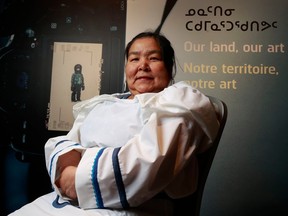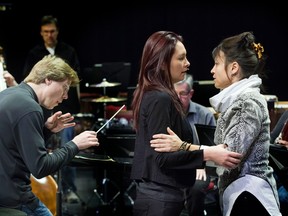'We’re so isolated from the rest of the world. But with the Internet finally starting to get faster, we will see a lot more people sharing information on how we live, how we hunt and just to show the world we exist.'

Reviews and recommendations are unbiased and products are independently selected. Postmedia may earn an affiliate commission from purchases made through links on this page.
A new exhibition at the Canadian Museum of Nature juxtaposes digital images with ancient cultural artifacts to tell a story of survival in Nunavik, a remote region where more than 10,000 Inuit make their homes in 14 coastal villages.
Organized by the Avataq Cultural Institute and displayed in the Ottawa museum’s Northern Voices gallery, the exhibition Our Land, Our Art is designed to shine a spotlight on the northern part of Quebec known as Nunavik, not to be confused with the northern territory of Nunavut, which encompasses the rest of the Canadian Arctic.
Sign up to receive daily headline news from Ottawa Citizen, a division of Postmedia Network Inc.
Thanks for signing up!
A welcome email is on its way. If you don't see it, please check your junk folder.
The next issue of Ottawa Citizen Headline News will soon be in your inbox.
“People tend to mix or confuse Nunavik and Nunavut,” said Rhoda Kokiapik, executive director of the Inukjuak-based institute, which also has an office in Montreal, more than 1,300 kilometres south. “This exhibit represents the variety of artists and artistic practices that Nunavik has.”
The work ranges from a video installation depicting the athleticism of Tupiq A.C.T., an Arctic circus troupe formed in 2018, to everyday objects that were used by early Inuit hundreds of years ago, including a marmite cooking pot, knives made from walrus ivory and a pair of snow goggles.
For 23-year old photographer Lukasi Kiatainaq, whose images were discovered by the institute on his Instagram account, it’s a thrill to be included in the show. He’s been taking pictures since 2016, the year he participated in Students on Ice, a program that brings youths on educational expeditions to the polar regions.
“I never really had the intention to be in an exhibition when I started taking photos,” Kiatainaq said in an interview. “I just wanted to show what I see in my town and the beauty of the land I live in.”
His photos capture spectacular images of wildlife, while his video, That Spring Feeling, portrays fishing and hunting activities in the spring, including the harvesting of a beluga whale.
“It’s one of the best times of the year,” Kiatainaq says of the spring hunt. “It’s warm enough to be out on the land all day and so many animals are crossing our land and available to be harvested.”
Meanwhile, Qumaq M. Iyaituk, a 68-year-old elder from Ivujivik with decades of experience in a wide range of artistic practices, illustrates both the resilience of the Inuit and the impact of industrialization in her understated work.
In one painting that shows two dog sleds ready for travel, she points out the use of paint, wood and metal, materials that became available in the modern age, and the fact that the two sleds are parked close together to block the strong winds. In another painting by her sister, Passa Mangiuk, a motorized canoe is covered with canvas so it doesn’t fill with snow, and then tied down.
“I’m trying to show my culture,” Iyaituk said. “How we live, how we survived in the past, and how we still survive. I don’t want my great-grandchildren to forget who we are. Our ancestors survived the land and I’m proud of them because there’s nothing there. They were so smart. It took the whole community to survive.”
The exhibition also includes beadwork and art by Taqralik Partridge and audio recordings of throat singers Evie Mark and Akinisie Sivuarapik. It runs to October 2024.

With high-speed Internet starting to become more widely available in the North and more young Inuit sharing their experiences on social media, Kiatainaq predicts more attention for his remote homeland.
“We’re so isolated from the rest of the world,” he said. “But with the Internet finally starting to get faster, we will see a lot more people sharing information on how we live, how we hunt and just to show the world we exist. I feel like this exhibition is a great step towards that.”
lsaxberg@postmedia.com
-

The Stairwell Carollers ring in the season of Christmas music
-

Things to do in Ottawa this week: See Sugar Plum fairies, eat fondue, celebrate hip hop


